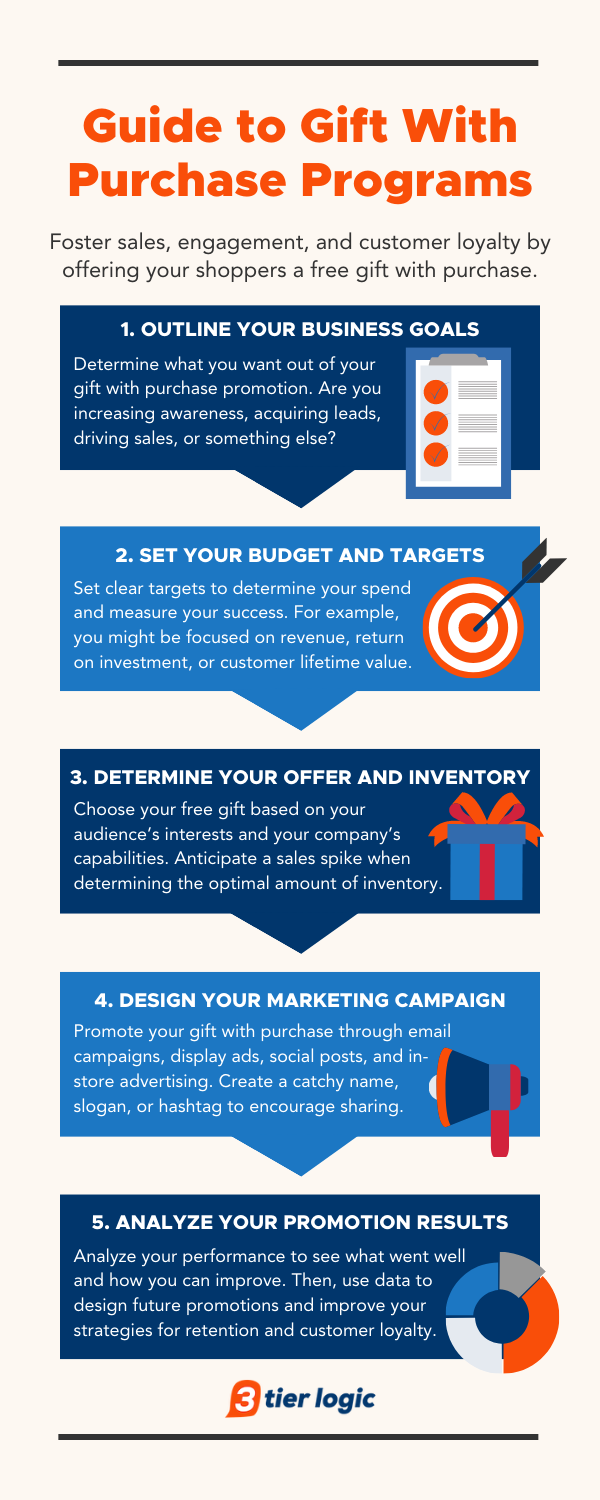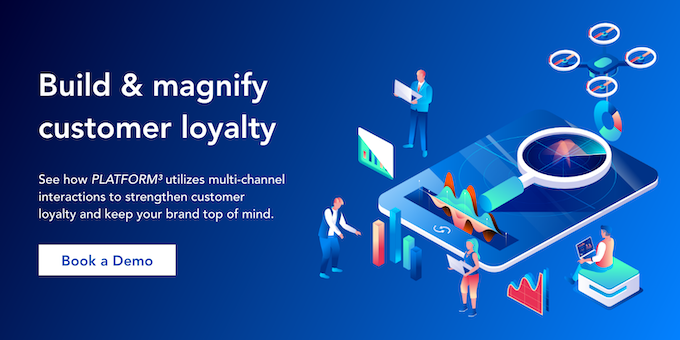Complete Guide to Gift With Purchase Programs (Examples Included)
Consumers are driven by objectives and incentives, whether it’s signing up for a mailing list to get special offers, entering a sweepstakes contest for the chance to win an exclusive getaway, or purchasing one product to qualify for another at 50% off. One of the best ways to get shoppers to engage with brands is to reward them with a free gift when they complete a desired purchase - also known as a gift with purchase promotion. What is a gift with purchase program, and how does it foster sales and customer loyalty?
What is a gift with purchase (GWP) promotion?
A gift with purchase (GWP) promotion is a type of sales tactic where brands offer consumers a free gift when they purchase a specific product and/or spend a specified amount. For example, a pet food brand could ask shoppers to purchase two bags of dog food from a particular product line or $30 worth of cat treats to qualify for a reward. Gifts can range from physical rewards like brand merchandise and free products to digital rewards like discount codes for online purchases. Brands can also offer cashback rewards and physical or digital gift cards. Gifts can either be equal to, less than, or greater than the value of the initial purchase, depending on the brand’s budget and business objectives.
Gift with purchase programs can also be incorporated into other types of marketing promotions. This helps to generate more sales and engagement than if either promotion were to stand on its own. Brands often combine GWP with sweepstakes and contests to increase customer participation. For example, during Bimbo Canada’s Go POM Go Sweepstakes, shoppers purchased two qualifying POM products to receive a $5 Visa digital gift card and a chance to win 1 of 4 Suite packages to a Montreal Canadiens game, 1 of 20 Montreal Canadiens accessories, or 1 of 5 $500 Visa physical gift cards. Consumers get the thrill of potentially winning something of high value while getting the instant gratification of immediately receiving something of a lower, but still significant value.
Benefits and challenges of gift with purchase promotions
Benefits of gift with purchase promotions
The main advantage of gift with purchase programs is their ability to spread awareness and drive brand recognition. While shoppers might not be interested in a storewide sale or a limited-time discount, they may find it hard to turn down the chance to get something for free. Brands can get people’s attention with marketing phrases like “free gift with purchase” or “buy one, get one free”, then encourage them to share the promotion with friends and family. They may even capture the interest of audiences who initially had no intention of engaging with them, resulting in more potential leads and eventual customers.
When done right, gift with purchase promotions can also lead to increases in sales and customer loyalty. Brands often use GWP programs to upsell their products and increase repeat purchases. For example, they can offer gifts for purchases over $30 to tempt customers who have already spent $25. They can ask shoppers to purchase multiples of an item instead of just one. Lastly, they can get consumers to purchase less popular products by offering a free popular product in return. Shoppers are more likely to stick with brands that have a history of free gifts and giveaways, resulting in higher levels of user retention and customer loyalty.
Lastly, gift with purchase programs can also support a brand’s data collection efforts. Data, especially first-party data, informs their business plans and empowers their marketing strategies. Marketers need data to make accurate decisions, reduce assumptions and risks, drive sales and conversions, and improve user experience and customer loyalty. Brands can use gift with purchase programs to gain actionable insights about their customers and their purchasing habits. For example, they might learn that shoppers are more likely to engage if they’re asked to buy a certain number of products instead of a specified purchase value. They may discover that consumers are more interested in gift cards than free products. Marketers can then take this information to design future gift with purchase programs and other types of promotions, increasing their efficiency and effectiveness over time.
Challenges of gift with purchase promotions
The main challenge of gift with purchase programs is striking the right balance between supply and demand. Brands should look at their available data to determine the anticipated number of participants and the resources needed to meet their expectations. This may include their program budget, production and distribution capacity, and customer service requirements.
Brands also need data to understand what consumers are looking for and what they would do to get it. Otherwise, they risk offering a gift that shoppers don’t care about or creating barriers that diminish consumer interest. For example, if they use GWP programs to encourage sales of their least popular product, they may not get as many participants as anticipated. If most of their products are under $30 but customers need to spend $100 to qualify for a gift, shoppers may not want to spend significantly more than usual to reach the threshold.
Step-by-step guide to gift with purchase programs
1. Outline your business goals.
Marketers need start by determining what they want to get out of their gift with purchase promotion. Is the main purpose of the program to increase brand awareness, acquire new leads, drive sales and engagement, or something else? Is this promotion meant to achieve a short-term objective or support a long-term action plan?
2. Set your budget and targets.
Brands should set a clear budget and targets to determine their promotion and marketing spend, as well as to measure the program’s success. Depending on their goals, this may include acquiring a specific number of new leads or redeeming a specific number of rewards. Brands might also focus on revenue, return on investment, customer acquisition costs, and customer lifetime value.
3. Determine your offer and inventory.
Marketers need to choose their free gift based on their audience’s interests and behaviors and their company’s budget and capabilities. They should anticipate a spike in sales when determining the optimal inventory for both the products they’re promoting and the gifts they’re distributing, whether it’s free items, brand merchandise, cashback rewards, and so on.
4. Design your marketing campaign.
To increase awareness and engagement, brands should promote their gift with purchase programs through email campaigns, display ads, social media posts, and in-store advertising. Marketers can create a catchy name, slogan, or hashtag to improve brand recall and encourage shoppers to share the promotion. They should also consider having a separate landing page or microsite to maintain focus on the gift offer and track the promotion’s performance.
5. Analyze your promotion results.
At the end of their gift with purchase program, marketers need to analyze their performance by looking at data to understand what went well and how they can improve. For example, did they overestimate or underestimate the number of participants? Did they spend too much or too little on marketing? Were they able to spread brand awareness, acquire new customers, or drive repeat purchases? They can then use this data to design future promotions and improve their strategies for segmentation, retention, and customer loyalty.
Gift with purchase program best practices
Align objectives and incentives
To create an effective gift with purchase program, brands should choose their qualifying products and free gifts based on their business goals, not the other way around. For example, if they want to generate revenue, they should get shoppers to purchase one of their high-value products. If they want to drive repeat purchases, they should ask customers to purchase multiples of a specific item before they qualify for a free gift. Lastly, if they want to spread awareness, they should reward consumers with brand merchandise or their most talked-about product.
Create demand and urgency
Gift with purchase programs help brands leverage a psychology tactic called instant gratification, which is the desire to have our needs fulfilled immediately without delay. It helps reduce friction, increase conversions, and foster loyalty - as when consumers want something, they want it now. Marketers can use this to their advantage to generate demand and increase engagement. For example, is the promotion only available for a few weeks? Are there a limited number of prizes? Is the reward an exclusive item that shoppers can’t get anywhere else? Not only does this help brands determine the terms and conditions of their promotion, but it also provides strong direction for their marketing campaigns as well.
Prioritize branding and timing
Shoppers are more likely to remember brands that provide free gifts over those that provide discounts, even if they had no initial interest in the brand’s products. Companies should use gift with purchase programs to strengthen their brand identity and improve brand recall through effective marketing strategies. For example, they can create a promotion-specific hashtag to encourage consumers to create user-generated content and spread the word. They can advertise the promotion in-stores and on their packaging so shoppers form positive impressions of their brand, logo, and products. Marketers also need to focus on the timing of their promotion. They can tailor their offer to work in tandem with holidays, seasons, or special occasions. For example, Giant Eagle, King’s Hawaiian, and Wrigley created gift with purchase programs as a tie-in with Christmas, summer, and the back-to-school season, respectively.
Capture and leverage consumer data
As mentioned previously, gift with purchase programs are a great opportunity for capturing user first-party data, including their contact information and purchasing behavior. Brands can also collect data about how shoppers discovered their promotion, engaged with their marketing efforts, and so on. Data keeps marketers well-informed about what worked and what didn’t, such as what types of gifts were most effective or which ad campaigns led to the most reward redemptions. Companies like Reckitt Benckiser, Hershey’s, and Ben’s Original collected data in their respective gift with purchase programs to gain user insights, guide business decisions, and improve future promotions.
Create effective gift with purchase promotions for nuturing customer loyalty
Gift with purchase programs are the perfect way to generate awareness, drive sales, and foster customer loyalty. Shoppers like to be rewarded, which companies can do by offering free products, brand merchandise, gift cards, and more in exchange for completed purchases. Gift with purchase promotions also help brands capture first-party data to inform future business decisions and marketing campaigns, leading to continuous opportunities and growth as a result.
3 tier logic’s PLATFORM³ helps brands create marketing campaigns like gift with purchase promotions, contests and sweepstakes, loyalty programs, and more to drive user retention and capture first-party data. Modules like Gift Cards & Rewards and Data Capture & Analytics provide marketers with the tools they need to design effective promotions and make strategic decisions for growing their business. To learn more, book a demo with our team today.



